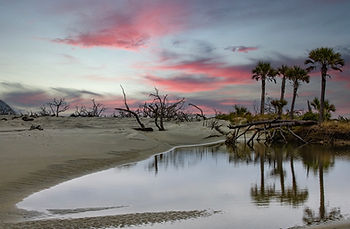Wild Island Nature Garden Project

Photo Courtesy of Robert Gecy – Wild Island Nature
Introducing FOHI's newest volunteer project!
Join the Wild Island Nature Garden Project and become a vital part of preserving the stunning natural beauty of Hunting Island State Park. Our project focuses on cultivating native plants, nurturing local wildlife habitats, and enhancing the park's visitor facilities.
As a member, you will not only play a key role in conservation efforts but also immerse yourself in the rich biodiversity that makes Hunting Island truly special. Your dedication and passion can make a lasting impact, ensuring that generations to come can enjoy our beautiful landscapes.
Led by Master Gardeners, the teams will be assigned locations throughout the Park to maintain and cultivate, while learning the landscape and vegetation from our seasoned project leaders.
Become a Member and select this category on the Volunteer Form and we will contact you as we develop this newly created core conservation project.
Join us today in this rewarding endeavor and help preserve the magic of Hunting Island State Park.
Maritime Forests
-
Dominant Trees:
-
Live Oak (Quercus virginiana): A key tree species in the maritime forest, known for its sprawling canopy and distinctive, moss-draped appearance.
-
Southern Pine (Pinus palustris and Pinus elliottii): Longleaf and slash pines are prevalent in the park and provide critical habitat for various wildlife.
-
Palmetto (Sabal palmetto): The state tree of South Carolina, the palmetto is common in the understory and along forest edges.
-
Other Vegetation:
-
Wax Myrtle (Morella cerifera): A common shrub in the forest understory, providing food for birds.
-
Ferns and Vines: The forest floor is also home to several species of ferns, such as the Christmas Fern (Polystichum acrostichoides), and climbing vines like Passionflower (Passiflora spp.).
Salt Marshes
-
The salt marshes surrounding the island are vital to the park’s ecosystem, providing habitat for a variety of coastal species.
-
Common Salt Marsh Plants:
-
Smooth Cordgrass (Spartina alterniflora): A dominant species that helps stabilize the marsh, preventing erosion and providing habitat for fish and invertebrates.
-
Saltbush (Baccharis halimifolia): A shrub found in the higher parts of the marsh, which supports various bird species.
-
Glasswort (Salicornia spp.): A salt-tolerant plant that thrives in the saline conditions of the marsh.
-
Coastal Dunes and Beach Vegetation
-
Seaside Goldenrod (Solidago sempervirens): A bright yellow flowering plant that is often found along the edges of dunes and beaches.
-
Beachgrass (Ammophila breviligulata): This grass is essential for dune stabilization, preventing the sand from blowing away and forming the coastal dunes.
-
Prickly Pear Cactus (Opuntia humifusa): Found in some of the drier dune areas, this cactus can tolerate the harsh conditions of the beach.
Tidal Creeks and Wetlands
-
Along the tidal creeks and freshwater wetlands, you’ll find plants adapted to frequent inundation with brackish or freshwater.
-
Common Reed (Phragmites australis): This tall grass grows in wetlands and creek edges.
-
Cattails (Typha spp.): Found in standing water or slow-moving streams, cattails provide habitat for various aquatic animals.
-
Bulrush (Schoenoplectus spp.): A plant often found in the shallow waters of tidal creeks, providing nesting areas for birds.
Boneyard at South Beach
-
The Boneyard on Hunting Island is a striking and somewhat eerie spot. It’s a beach area on the island, located in Hunting Island State Park in South Carolina. What makes it so memorable is the large number of dead trees scattered along the shore, creating an almost otherworldly scene. These trees, many of which are saltwater-resistant and have been bleached white by the sun, give the place a haunting beauty.
-
A popular spot for photographers because of the dramatic effect of the decayed trees against the backdrop of the Atlantic Ocean, the trees are remnants of the forest that once stood in that area but were eventually washed away by the shifting tides, storms, and erosion.
-
People often walk out there for the unique experience, to explore the shoreline, and to enjoy the peaceful solitude. If you're into nature, the Boneyard is one of those spots where the stark beauty of decay really stands out.
Rare and Special Vegetation
-
Carolina Jessamine (Gelsemium sempervirens): A fragrant, yellow flowering vine that blooms in the spring.
-
Pitcher Plants (Sarracenia spp.): These carnivorous plants can be found in the park’s wetland areas, where they capture and digest insects.
-
Turk’s Cap Lily (Lilium superbum): A native wildflower with bright orange, reflexed petals that grow in moist environments.
Adaptations of Flora at Hunting Island:
-
Salt Tolerance: Many of the plants in the salt marshes and coastal areas are halophytes, meaning they can tolerate or thrive in salty environments, such as the Saltbush and Smooth Cordgrass.
-
Wind and Drought Resistance: Many of the plants, such as the Beachgrass and Palmetto, are adapted to the wind and the occasional drought conditions that come with the coastal environment.
-
Flood Tolerance: Vegetation in the tidal marshes and wetland areas must cope with periodic flooding due to the tides. Many plants in these habitats, like Cattails and Marsh Mallow (Hibiscus moscheutos), are adapted to standing water.
Conservation Importance:
Hunting Island’s vegetation plays an essential role in stabilizing the island’s fragile ecosystems. Plants like the Beachgrass and Seaside Goldenrod help prevent dune erosion, while the marsh grasses act as nurseries for marine life. The diverse plant communities also provide food and shelter for a variety of wildlife species, including migratory birds, insects, and marine life.
The park is a dynamic natural area, and its flora contributes significantly to the aesthetic beauty and ecological integrity of the region.
Please visit the Flora at Hunting Island State Park for species identification









